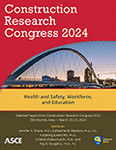Exploring the Hypothesized Mechanisms by Which Serious Injuries and Fatalities Impact Business Performance
Publication: Construction Research Congress 2024
ABSTRACT
Beyond the extreme human cost, serious injuries and fatalities (SIFs) also negatively impact the business performance of construction firms. The mechanisms operate through tangible factors (e.g., downtime, reduced productivity) and intangible factors (e.g., lower employee morale, loss of company reputation). To explore the significance and interactions of the factors influenced by SIFs, 15 safety professionals representing various industry sectors spanning from construction to technology, consulting, and insurance firms were surveyed. Specifically, they rated the extent to which each of 13 business factors impacted by SIFs in turn adversely influences one another. A network analysis depicts the relationship between these factors and identifies the most influential ones. Preliminary findings suggest that both tangible and intangible factors influence business performance, with intangible factors perceived as more salient after a SIF occurs. Company reputation and managerial bandwidth are the most prominent factors, while third-party prequalification, lawsuit probability, and productivity were ranked as less relevant. In contrast to contractors, owners perceive workers’ mental health as a more important factor influencing the business bottom line when a SIF occurs. This study adds to the literature on how safety performance impacts firms’ profitability by exploring the influence of each factor and their interactions with one another.
Get full access to this article
View all available purchase options and get full access to this chapter.
REFERENCES
Bhandari, S., and M. R. Hallowell. 2021. “Identifying and controlling biases in expert-opinion research: Guidelines for variations of Delphi, nominal group technique, and focus groups.” J. Manage. Eng. 37 (3), 04021015. https://doi.org/10.1061/(ASCE)ME.1943-5479.0000909.
Borgatti, S. P., M. G. Everett, and L. C Freeman. 2002. “Ucinet for Windows: Software for social network analysis.” Harvard, MA: Analytic Technologies. 6, 12–15.
Cohn, J. B., and M. I. Wardlaw. 2016. “Financing constraints and workplace safety.” The Journal of Finance, 71 (5), 2017–2058.
Haupt, T. C., and K. Pillay. 2016. “Investigating the true costs of construction accidents.” Journal of Engineering, Design and Technology. 14(2), 373–419.
Kreshpaj, B., et al. 2022. “Business performance and occupational injuries trajectories in the construction sector in Sweden.” Safety science. 152, 105772. https://doi.org/10.1016/j.ssci.2022.105772.
Hallowell, M. R., and J. A. Gambatese. 2010. “Qualitative research: Application of the Delphi method to CEM research.” J. Constr. Eng. Manage. 136 (1), 99–107. https://doi.org/10.1061/(ASCE)CO.1943-7862.0000137.
Hinze, J. 1997. Construction safety. Prentice Hall.
Huang, Y. H., J. Lee, A. C. McFadden, L. A. Murphy, M. M. Robertson, J. H. Cheung, and D. Zohar. 2016. “Beyond safety outcomes: An investigation of the impact of safety climate on job satisfaction, employee engagement and turnover using social exchange theory as the theoretical framework.” Applied ergonomics. 55, 248–257.
Lebeau, M., P. Duguay, and A. Boucher. 2014. “Costs of occupational injuries and diseases in Québec.” J. Saf. Res. 50, 89–8. https://doi.org/10.1016/j.jsr.2014.04.002.
Miller, T. R., and M. Galbraith. 1995. “Estimating the costs of occupational injury in the United States.” Accident analysis & prevention. 27(6), 741–747.
Neely, G. H. 1999. The relationship between employee morale and employee productivity. National Fire Academy.
O’Brien, D. P. 1999. Business measurements for safety performance. Boca Raton, FL: CRC Press.
Office of Construction Prequalification. 2023. “Guide to construction prequalification.” Accessed August 19, 2023. https://www.columbus.gov/finance/financial-management-group/office-of-construction-prequalification/.
Takala, J., P. Hämäläinen, K. L. Saarela, L. Y. Yun, K. Manickam, T. W. Jin, and G. S. Lin. 2014. “Global estimates of the burden of injury and illness at work in 2012.” Journal of occupational and environmental hygiene. 11 (5), 326–337.
Vij, S., and H. S. Bedi. 2016. “Are subjective business performance measures justified?” International Journal of Productivity and Performance Management. 65 (5), 603–621.
Waehrer, G. M., X. S. Dong, T. Miller, E. Haile, and Y. Men. 2007. “Costs of occupational injuries in construction in the United States.” Accident Analysis & Prevention. 39 (6), 1258–1266.
Wasserman, S., and K. Faust. 1994. Social network analysis: Methods and applications. Cambridge, United Kingdom: Cambridge University Press.
Information & Authors
Information
Published In
History
Published online: Mar 18, 2024
ASCE Technical Topics:
- Business management
- Business organizations
- Commercial construction
- Construction companies
- Construction costs
- Construction engineering
- Construction industry
- Construction management
- Employees
- Employment
- Human and behavioral factors
- Occupational safety
- Organizations
- Personnel management
- Practice and Profession
- Project management
- Public administration
- Public health and safety
- Safety
Authors
Metrics & Citations
Metrics
Citations
Download citation
If you have the appropriate software installed, you can download article citation data to the citation manager of your choice. Simply select your manager software from the list below and click Download.
